Nearly 300 students ages 16+ receive their first dose of the COVID-19 vaccine
By PAIGE TIMBROOK ’22 STAFF WRITER
As the COVID-19 pandemic continues to significantly impact our society, the administration quickly became determined to provide the Hill community with access to the vaccine. With nearly 83% of the eligible student body on pace to be fully vaccinated by May 13, the administration is hoping to create a safer and more normal environment for the last six weeks of the school year.
Having developed a prior relationship with Rite Aid for the flu vaccination clinic, Hill communicated with this company for nearly two months about the possibility of a COVID-19 vaccination clinic on campus. “I continued to reach out to them because our goal is to make it to graduation and provide the 6th formers with the most normal experience possible,” Heather Gelting, director of human resources, explained.
Knowing Rite Aid was expecting supply in the beginning of April, the administration sent out an email to parents on April 1 with TBD dates. On April 2, the school found out Rite Aid healthcare workers would be able to travel to campus on April 8 and provide students with the Pfizer vaccine. The administration quickly assembled a team to begin working on the consent form, effective communication with parents and the clinic layout on campus.
“We immediately stopped what we were doing to make this happen because this was a significant step toward community health,” Kristin Spencer, Hill’s medical director, said.
In the Mercer Field House on April 8, 273 students received their first dose of the vaccine. An additional 41 students have independently arranged for the vaccination.


“When we learned the vaccine was becoming more widely available, we believed we were eligible because we are a residential campus. This is an honor for our school because we were the first high school in the state of Pennsylvania to have this opportunity,” Gelting said.
When the students checked in, they received a card with an exit time. They were advised to drink a bottle of water before getting vaccinated and wait in the field house for 15 minutes afterward. When their time was up, they checked out at another table, and they were offered a card for the waffle truck as well as Tylenol.
“I had an overall positive experience,” Chelsea Mills ’22 said. “I was really surprised that they handled the clinic so professionally, and I feel very fortunate to have been able to receive the vaccine.”
With a large number of the student body obtaining the vaccine, the administration looks forward to conducting more activities within our campus bubble.
“If boarding students are not having outside exposures, we have a really high level of confidence that the 6th form will be able to congregate at graduation more than they would have been able to before,” Dean of Students Ari Baum said. That being said, the school is still very mindful of the case numbers rising, and they expect students to remain cautious for the rest of the school year.
Hill elects Sarah Jiang ’22 and Noah Toole ’22 as the next SGA Co-Presidents
By JENNIE KI ’23 STAFF WRITER
The 2021-22 Student Government Association election has come to an end. Newly elected SGA Co-Presidents Sarah Jiang ’22 and Noah Toole ’22 will assume their positions and lead Hill into the next school year. During the virtual co-presidential debate held on April 9, Jiang and Toole said they want to inspire the Hill community through cooperation and harmony within every Hill student member and faculty. The two will be the voice of the Hill community.

A goal set forth by the two co-president-elects is to help students integrate into the community of the Hill School.
“Noah and I had our fair share of struggling to be part of the community,” Jiang said. “So, we would like to reach out to students who are new or who are having a hard time fitting in. The best way is to reassure them that it takes time, but eventually, it will get better.”
Through their experiences at Hill, both co-president-elects
emphasized the importance of empathy and understanding between the SGA and student body.
Jiang and Toole also reaffirmed the missions and responsibilities to Hill that SGA co-presidents hold.
“We emphasized that Noah and I want to lead while serving the school and not the other way around. Many people might find the SGA intimidating, especially for incoming third formers. We would like to make students comfortable. We will try to lessen ourselves as presidents and more like peers who have the voices that can talk to faculty,” Jiang said.
In addition, Toole said, “Third formers are important because they are the future of the Hill School; and they are new, so they are anxious and scared. We will try to immerse them into the Hill family and show them what Hill is about. If third formers feel involved and in the culture, everyone’s morale will overall increase.”
Inspired by the actions of current Co-presidents Sasjha Mayfield and Andrew Chirielieson,
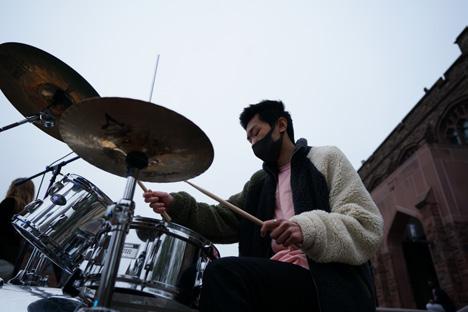
Noah and I had our fair share of struggling to be part of the community. So, we would like to reach out to students who are new or who are having a hard time fitting in. The best way is to reassure them that it takes time, but eventually, it will get better.
—Sarah Jiang ’22
Third formers are important because they are the future of the Hill School; and they are new, so they are anxious and scared. We will try to immerse them into the Hill family and show them what Hill is about. If third formers feel involved and in the culture, everyone’s morale with overall increase.
—Noah Toole ’22
Jiang and Toole hope to create a more inclusive environment on campus regarding race, gender, and sexuality.
“Noah and I want to push activities such as the DEI, HASOGI, and advisory BLM talks. We would like to bring awareness and create a natural atmosphere for talks,” Jiang said.
During and after the co-presidential debate, Jiang and Toole both expressed determination to further lead the community with more unity and harmony. “We want to see the community succeed and better our school,” Toole commented. Understanding the Hill students’ various perspectives and experiences, the SGA co-president-elects are determined to create a friendly culture within the Hill School.
10, 8 p.m. to 9 p.m., on Zoom.
Hill’s female students discuss how the administration handles sexual abuse
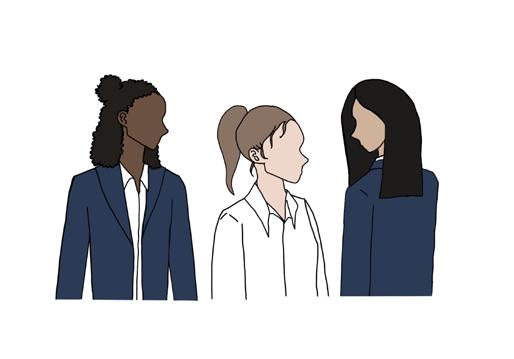
APs, with the anxiety and the limitation they bring, have increasingly become a hindrance to students’ academic pursuits. It’s time for us to reconsider the future of APs at Hill.

For 23 years, women and girls have occupied the halls of The Hill School as students. Looking in from the outside, it is a community that flows with autonomy; but a very different picture is painted from the inside.
The lights dim as hundreds of students and parents pour into the auditorium. The air is heavy with anticipation, eagerly awaiting the lively performance.
NEWS
VOLANT, SCRIPTA MANENT April 28, 2021 VOLUME CXXI. NO.XII
THE HILL
VERBA
PHOTO BY ERICK SUN ’24
PHOTO BY ERICK SUN ’24
SUN ’24
PHOTO BY ERICK
Live music returns in the spring
Hill’s future is brigher without APs
More news on SGA: Form debates take place on May
Rite Aid
prepares to administer
Kieu Anh Hong ’21 receives her first dose of the Pfizer vaccine.
A
clinician
Pfizer vaccine.
Noah Toole ’22 and Sarah Jiang ’22 hope to aid third formers.
Local leaders discuss economic inequality in Pottstown
Systemic inequality has been a deep infection in the U.S. economy for decades, stemming out of racial bias, but also economic factors. Pottstown reached its economic zenith around 1960 and expanded through the 1970s as industries were drawn to the city. These industries boomed during this age and, as a result, downtown Pottstown saw the opening of many consumer stores. However, since the 1970s, the borough has become rather stagnant. Many of Pottstown’s major industries were drawn to other areas. Today, 19% of the Pottstown population lives below the poverty line. The economic strength and stability of Pottstown has continued to decrease, and many local leaders attribute this to systemic inequality.
Wendy Egolf, director of housing programs at the Lessig Booth Family Residence Homeless Shelter, explained that systemic inequality in Pottstown began with the moving away of large industries.
“Some of the systemic economic difficulty in Pottstown
comes from large industries moving out of town, like Mrs. Smith’s Pies, Swanson Foods, and the steel industry. Long-time factory workers lost their jobs and were not near retirement. This was devastating to people who earned a good salary and could no longer find work that they were qualified to do,” Egolf said.
William MacGregor, director of Pottstown Works – an NGO focused on providing job training to the disabled and economically challenged of Pottstown – explained that the lack of Pottstown’s preparation to compete with big businesses in the past has allowed systemic inequality to infect Pottstown’s economic system. He believes economic difficulty in Pottstown can be attributed to four systems.
“I identify four areas of systemic inequality in Pottstown at present: A transit system that ends where the borough does, ... a nearly complete absence of quality daycare available within the borough; an absence of ongoing workforce development and retraining with open access; [and] an operating theory of economic development that completely overlooks the basic needs
of many residents required to live a dignified life,” MacGregor said.
Barbara Wilhelmy, executive director of the Pottstown Cluster, one of the largest food shelters in the area, also believes that transportation is a large issue.
“Our transportation makes it very difficult for people in our region to get to those opportunities without added significant time to an already challenging day,” she said.
MacGregor also believes that the inherent silent and selective nature of economic systemic issues makes them even more debilitating.
“One of the issues with systemic inequality is that it frequently flies under the radar; many people are unaware of it because it doesn’t affect them directly. Also, the people most affected by systemic inequality are typically people who are already marginalized and, therefore, [treated as] less important, or not important at all,” MacGregor
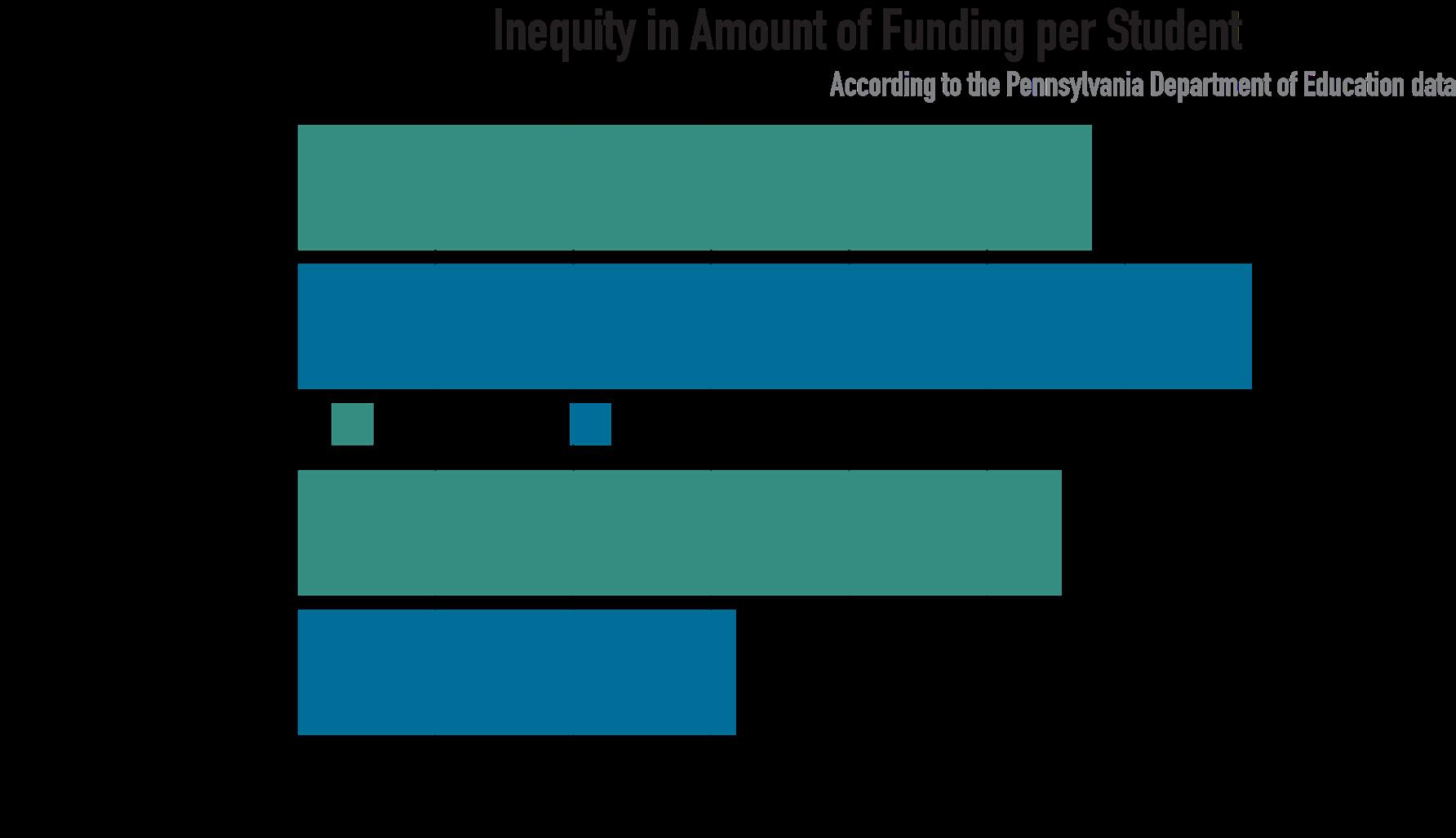
explained.
Though systemic inequality has evidently affected Pottstown, Wilhelmy, MacGregor, and Egolf, each leaders of their own respective NGOs, are working hard to overcome the aforementioned issues.
MacGregor focuses on factors he can control in an age of chaos and economic struggle.
“We focus primarily on barriers that our members can control, to a large extent – the absence of certain skills and materials needed to apply for, secure and keep a job. The other barriers that I mentioned above are out of our immediate control, so we have to educate, lobby and cajole in order to make progress on removing them,” he explained.
Wilhelmy also sees the importance of spreading awareness when it comes to factors that are uncontrollable.
“I believe our organization is trying to be more aware and engaged in advocacy efforts and
opportunities to speak with those who may have influence in helping to address these issues,” Wilhelmy said.
Egolf, and the NGO she leads, combats systemic inequality by giving special aid to those that have been homeless for more than a year in the past three years.
“For individuals with a disability and homeless history of more than 12 months in the last three years, The Salvation Army has a permanent supportive housing program with scattered sites throughout Montgomery County so people can live in the area of their choosing and have case management assistance,” Egolf said.
Systemic inequality will continue to exist in Pottstown; however, with the support of Egolf, Wilhelmy, MacGregor, their respective NGOs and the many NGOs in the area, economic systemic inequality can be combated.
Pottstown politicians reflect on the impact of systemic racism
By CHELSEA MILLS ’22 STAFF WRITER
The Pottstown borough is a tight-knit community known for being intimate. Pottstown Councilwoman Trenita Lindsay likes to refer to the town as a “little village where everyone is very welcoming.” As a local politician, she does not feel as though systemic racism has had much of an impact in our area.
There is a racial issue, however, that has proved detrimental to the political and educational wellbeing of Pottstown. Both Councilwoman Trenita Lindsay and Mayor Stephanie A. Henrick agreed that schools are severely underfunded.
“The only issue that I know of in Pottstown deals with the fair funding of public schools,” Lindsay said.
Fair Funding of schools refers to a finance system that aims to provide equal opportunity for schools throughout districts in a state, as defined by the Education Law Center of Rutgers University. Student poverty is supposed to be accounted for, to ensure that income does not hinder their education. However, this is rarely the case.
As in many other districts, Pottstown is negatively affected by Fair Funding.
“Unfortunately, Pottstown
is over $65 million dollars underfunded. And it’s just a cumulative effect. It takes away programs in schools, competent teachers … It takes away everything,” Mayor Henrick stressed.
The issue was such a concern for Lindsay that it inspired her to get involved with politics. Despite this, she still speaks highly of local schools.
“We are the only school district in this area where you can go from pre-k to college all in one place. And you can pick up a trade in different specialties. It makes me want to go back to high school!” Lindsay said.
Lindsay thinks that there are many educational opportunities in Pottstown, but not enough. She uses her position to ensure that the state representatives are also fighting for educational equality. Fair Funding does not treat school districts fairly; there are other towns nearby that receive more money than Pottstown as a result of their racial and economic demographics.
“When we go to Harrisburg and fight for fair funding, we see these kids expressing how they feel knowing that there is better out there for them,” Lindsay said. “Pottstown is being underfunded by over $3 million dollars a student. The children are affected by it.”
69.6% and 68.3% of students in Mahanoy and Pottstown School Districts are economically disadvantaged, respectively. However, only 3% of students enrolled in Mahanoy SD are Black, whereas 33.8% of students in Pottstown SD are Black. The Fair
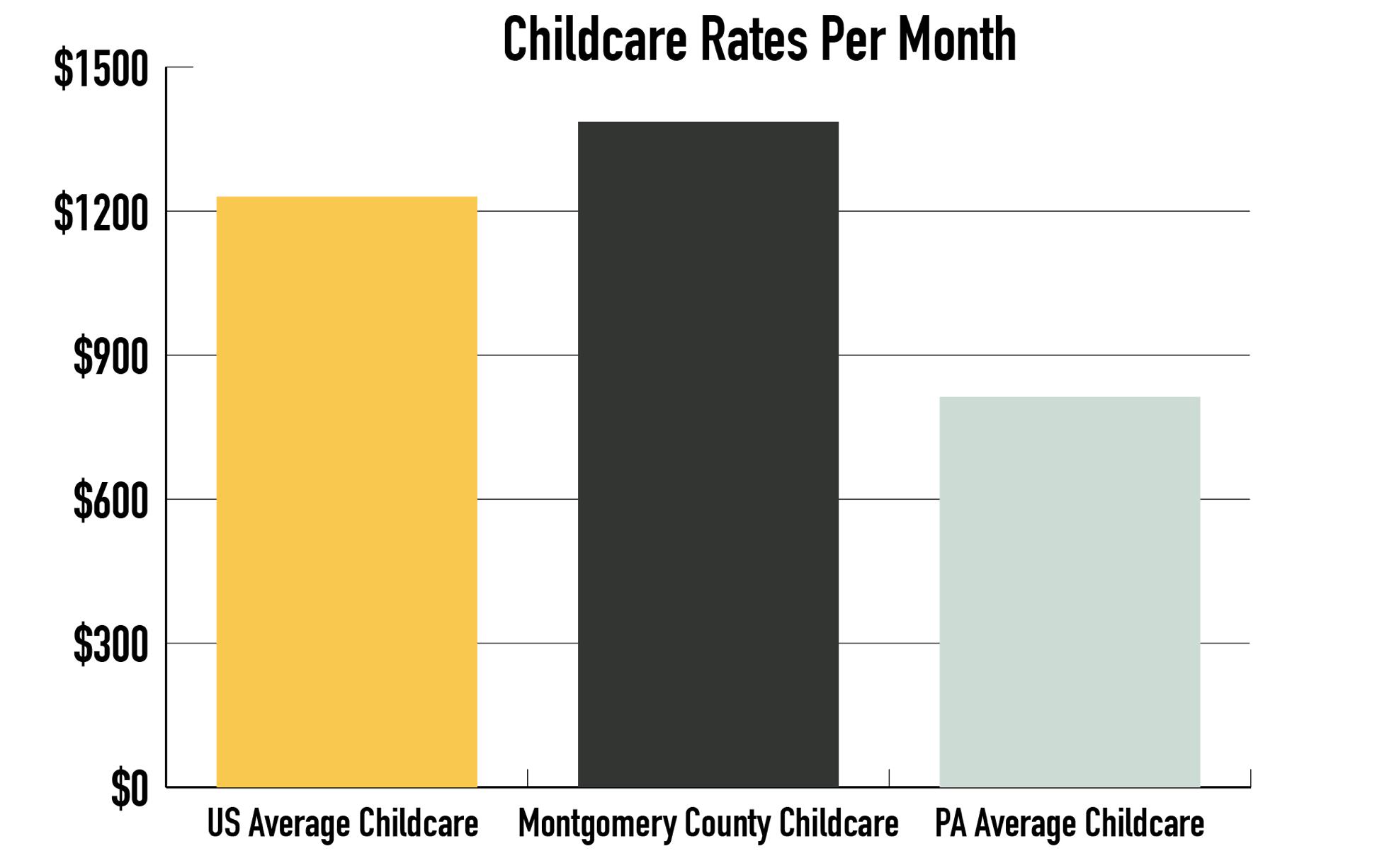
Pottstown has been underfunded for several years, but there is definitely hope for change in the education system.
Henrick also identifies housing in Pottstown as an issue based in racism. Despite her affection for the diverse and tightknit community, she recognizes that unfair housing has made life hard for people of color.
She believes that “because
of systemic racism, they have a harder time getting loans,” which leads to a “disportionate number of people of color being homeless and suffering from housing inequality.”

When people of color are given a chance, Henrick reports that they are typically forced into the sections of town that are in bad shape.
“We are trying to make sure
that landlords are providing equal housing and providing adequate inspections,” Henrick said.
In a few years from now, the politicians both hope that issues like these are resolved. But for now, they will continue rallying support for ending inequality in Pottstown.
The Hill News | A2 Local News APRIL 28, 2021
By PHILIPPE JIN ’21 LOCAL NEWS EDITOR
ILLUSTRATION BY CHLOE HAN ’22
GRAPHIC BY CLAIRE HARTEMINK ’21
GRAPHIC BY CLAIRE HARTEMINK ’21
Funding formula has created a disparity.
Source: Center for American Progress, carelulu.com, Economic Policy Institute
Source: Evan Brandt and David Mosenkis / Pottstown Mercury
Satire: The Hill School rings in the return of the Chapel bells
By MELODY CHEN ’22 & OLIVIA MOFUS ’22 STAFF WRITER FEATURES EDITOR
As Edgar Allen Poe writes in his poem The Bells, “To the rolling of the bells— Of the bells, bells, bells— To the tolling of the bells, Of the bells, bells, bells, bells— Bells, bells, bells—”, our campus, too, has become filled with the melody of Chapel bells.
Every 15 minutes, from 8 a.m. to 10 p.m., the tolling of the bells reminds us that time is, indeed, passing; the only certainty in this uncertain world.
They introduce an atmosphere of readiness: a Hill School student rises every day, 8 a.m. at the latest, and approaches the day with vivaciousness and alacrity. They absolutely, under no circumstances, take naps during lunch break, an action reserved for those with low mental tenacity.
Alarm didn’t sound? The Chapel bells won’t fail you: because if nobody got you, you know the Hill School Chapel bells got you.
But in all seriousness, have the bells been going off more this year than they have been before?
“The bells at Hill have gone off every 15 minutes for as long as they’ve been in use,” said Rev. Anne Confer Martens, warner associate chaplain. “It follows the pattern of Westminster Abbey. As a matter of fact, they rang every 15 minutes all of last year!”
Built in the 1900s, the Chapel is an integral part of campus. Traditionally, Chapel bells are used to call people to worship and mark time in communities when most people didn’t own timepieces.
“At some point last spring, they were either turned off or went out due to a power outage.
When we tried to turn them back on this fall, the system that controls the bells was no longer working, so we had them serviced and brought back to use,” Confer Martens said.
So why the controversy if nothing has truly changed?
“The thing about the Chapel bells is that they have been traditionally going off for so long that they’re just a part of our everyday life and routine here. It was only when they stopped, then started again, that people noticed them more,” Rev. Khristi Adams, firestone endowment chaplain, said.
Adams requested the volume be lowered after receiving constructive feedback from some students and faculty saying the bells were too loud. No one has since approached Adams with problems concerning the Chapel bells.
“Because my dorm room faces the quad, I definitely hear the Chapel bells often,” Paige Timbrook ’22 said. “I feel like I’m still getting used to them.”
Olivia: What’s your favorite Chapel bell tune, Melody?
Melody: I like the one that goes, da da da da, duh da da da da… dun… dun… dun… dun. Poetry.
Olivia: Really? How about the one that goes, da da, duh duh. I could cry.
“I enjoy hearing them, as they remind me of going to Chapel every week before the pandemic,” Timbrook said.
The Chapel bells will never leave you, unlike that boy you met on Tinder. The Chapel bells are a man. A man that has come back into Hill’s life once again.
Max Tsiang ’19 and Jingyu Cai ’19 check back in with Wave
By NOORIE DHINGRA ’21 STAFF CONTRIBUTOR
Wave, marketed as “a digitized school community platform,” is the Hill School’s app that manages students and their locations. Because of Wave, faculty members can easily find students as well as track any COVID-19 symptoms. Virtually everyone on campus uses Wave on a daily basis.
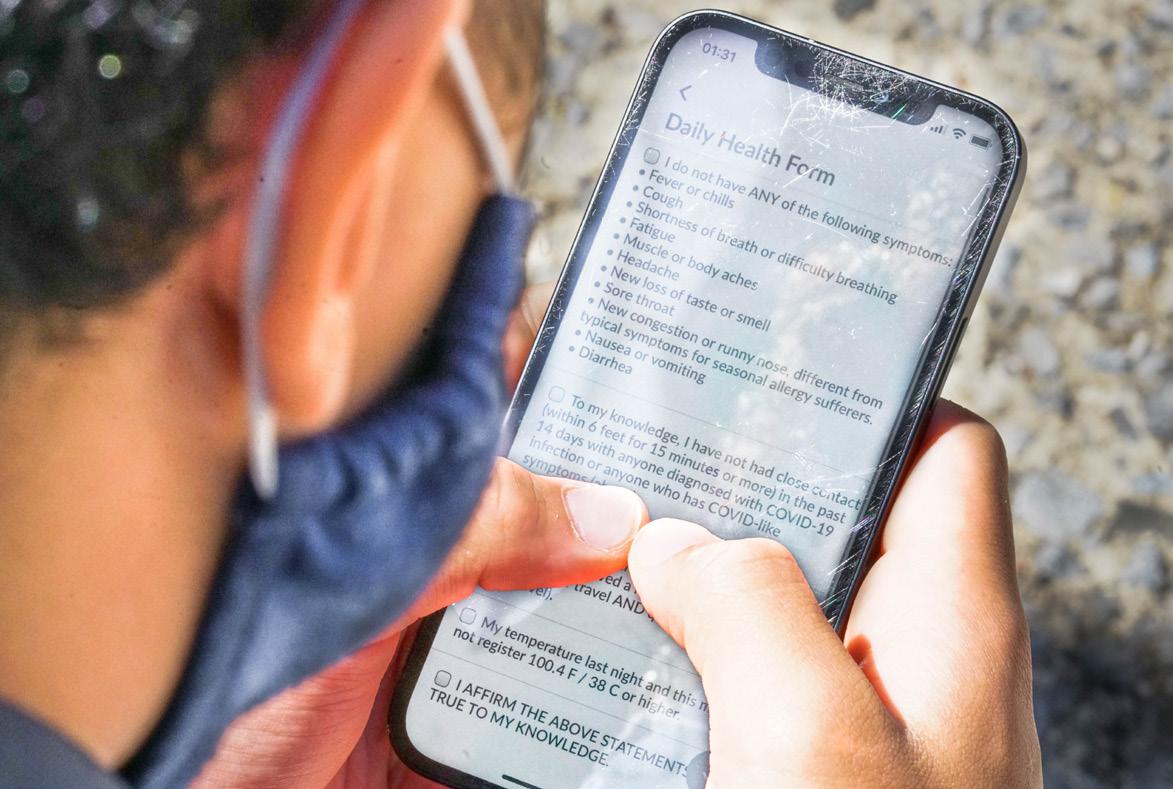
What some community members might not know is that Wave was created by two Hill alumni when they were students: Jingyu Cai ‘19 and Max Tsiang ‘19. Both alumni are currently pursuing a bachelor’s degree in computer science: Cai at the University of Chicago and Tsiang at the University of Pennsylvania.
Cai and Tsiang started Wave as a project during afternoon tech time with then computer ccience instructor Damian Baraty. According to Tsiang, Baraty jokingly said that if someone were to create a better REACH, he would build a statue of them on campus (For context, REACH is a boarding school app similar to Wave that Hill utilized in the past).
Cai and Tsiang decided to take on this challenge and collaborated with Ari Baum, dean of students, and David Allain, director of information and technology service. By keeping their end-users in mind, they wanted to optimize Wave as much as possible. According to Tsiang, the development process took one to two years since it was a part-time project, and they also wanted to be intentional with the design and features.
The first year that REACH was replaced by Wave was 2019. Now, due to COVID-19, Hill has increased its usage of the app. Throughout these past two years, Tsiang and Cai have been learning a lot about the software development process and making modular software to adapt to ongoing changes.
Initially, Tsiang and Cai were aiming
COVID-19 regulations affect classroom dynamics
By REASE COLEMAN ’22 STAFF WRITER
Classrooms throughout Hill are finding ways to work around the COVID-19 restrictions enforced. Gabriela Gomez, a language teacher, found herself moving her classroom outside to create a better work setting for the students. Videos are replacing conversations in class to avoid the muffled voices caused by the required face coverings.
New innovations are being discovered by the faculty members of Hill, but trying to achieve them takes a lot of trial and error.
“Nothing about this year has been easier,” Gomez stated in an email.
Although teaching a language might be difficult, there are other departments in The Hill School facing the same obstacles in similar ways.
Hill has been following the sixfeet socially distancing rule since the fall and continues to do so today. This includes the spacing inside the classroom setting: each individual desk is precisely distanced and limited to only a certain area.
“I had to change a lot because of the physical space restrictions that we had. Normally I have the desks that roll around and we’d always do different formations and kids could move into pair and group work,” Larissa Snyder, instructor of English, said. “It definitely changed the classroom dynamic.”
Teaching from a distance is an obstacle, but so is the virtual aspect. For all Hill teachers, this is the first year that they have had virtual and in-person students, creating an un-
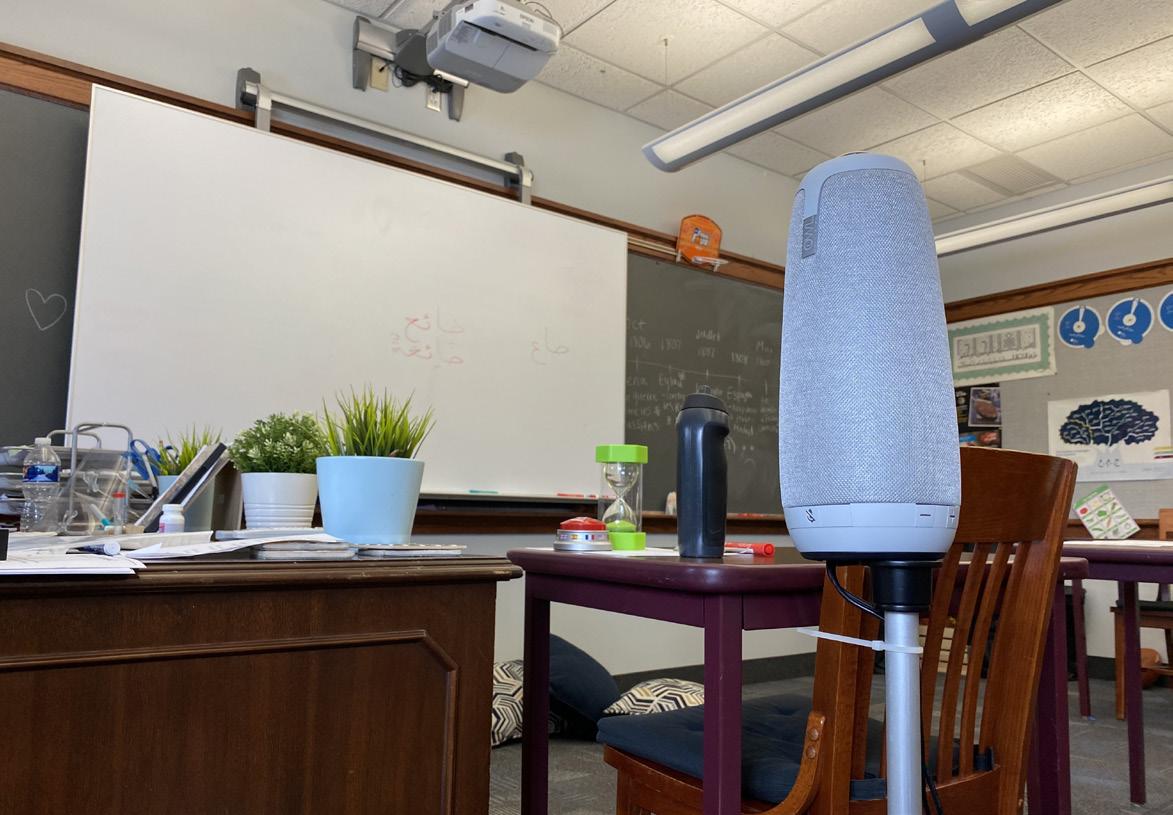
equal experience for the people at home.
“I think I’m pretty lucky that a lot of my virtual remote students are putting a lot of effort into doing the best they can in class,” Shannon Ruane, a science intern, said. “I wish they could be a lot more involved.”
Senior Master of Mathematics Matthew Gettings also said he has struggled to teach everyone and deal with the setbacks. Gettings described the experience as “challenging” but being able to teach has its own positive aspects.
Even though classes were being held, that did not mean every piece of content was covered. Many topics had to be removed from the curriculum based on the amount of time in the school year.
“We prioritized some topics where we had to leave out some classes because we felt like we just didn’t have enough time; we weren’t meeting as much,” Gettings said.
PHOTO BY ERICK SUN ’24
The pressure placed on the teachers for their lesson plans is seen all around campus, creating a sense of pressure among the teachers and students to complete the workload.
The school year at Hill comes to a conclusion on May 26. Many AP classes are also cutting down on the topics being taught, leaving their students unsure about the tests coming up.
“Almost all my classes either cannot finish the material on the test or are rushing through to complete the teaching material necessary for the assessments,” Sarah Jiang ’22 said. “I feel nervous about how my AP test results will turn out.”
COVID-19 restrictions and effects are seen taking a toll on the classroom setting. This past school year...
To read the full article, visit thehill.news.
to produce a “version two” that functioned more like commercial software, but they soon realized that working with other schools is a quite difficult and arduous process. For, now they plan to just focus on providing the software to Hill and catering it as much as possible for their alma mater.
Currently, Hill has a two-year contract with Wave. According to Wave’s website, its standard plan is $15/month/ user.
“We provided a discount for Hill for the two years since we appreciate the opportunity that Hill has given us to take on Wave: it’s an amount that we and Hill both feel happy with,” Tsiang said.
He also added that both he and Cai are hopeful that Hill will continue to partner with them.
Both developers want Hill to know that Wave was not an individual project, but rather a group effort.
“We had a lot of help from our friends and teachers. Even from day one, brainstorming the initial idea, to having to borrow phones to test and demo a rough version to ITS and the Deans’ Office, we had a lot of help from our friends. Most of all, we are grateful for the people at Hill that we had the opportunity to meet,” they said.
Tsiang and Cai said one thing they wish they’d known before graduating is that “the Three Brother’s California burrito is honestly the best burrito we’ve ever had (not sponsored).” They then added, “In all seriousness, we also wish we knew that it is OK to not have everything figured out (and neither of us have figured it out even now). It was definitely not smooth sailing at Hill: we’ve made mistakes, had rough weeks, and as much as we wish we had never experienced that back then, we are grateful for how it shaped us and how we learned from it, and in the end we turned out OK.
Ryan Park ’23 and Jojo Zhu ’22 earn success in the Montgomery County Science Fair
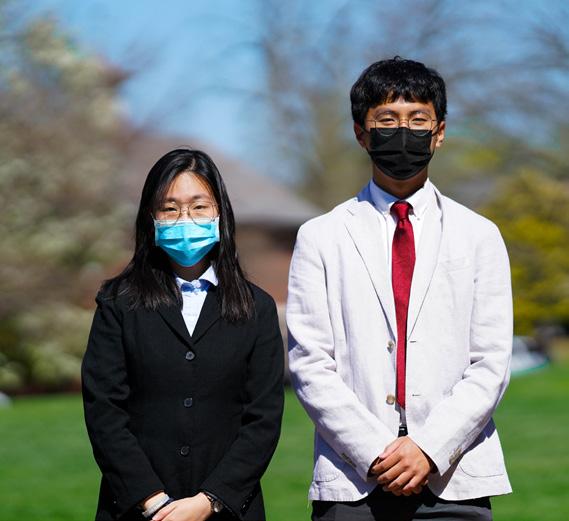 By MONIYAH PERSON-HENDERSON ’23 STAFF WRITER
By MONIYAH PERSON-HENDERSON ’23 STAFF WRITER
Ryan Park ‘23 and Jojo Zhu ‘22 participated and had success in the Montgomery County Science Fair. According to the Science Montgomery website, the fair is one of the largest in the United States. Middle and high school students from the Montgomery County area participate every year to win prizes such as scholarships, bonds, banquets, internships and many more.
Park did a study of Stereochemical and Thermodynamic Analysis of Nanoparticles used in the treatment of Alzheimer’s Disease. “I had to compute different sets of data and determine if it was effective or not to treat the disease,” Park said. Each week he met with Erin Ruane, the head of the science department, to discuss his research and work.
“Ryan spent a lot of time researching the molecular modeling software Avogadro.” Ruane stated in an email. “....Ryan used this software to study various physical and chemical properties of different chemical structures to determine their effectiveness in the treatment of Alzheimer’s Disease.”
He received second place in the Montgomery County Science Fair, and, although there is no “prize” for receiving this place, it qualifies him to continue competing in the Delaware Valley Science Fair.
Jojo Zhu ‘22, a boarding student from Shanghai participated in the H-term course Science, Race, and Injustice. She too received an award for her participation in the science fair.
“I learned how much of a passion I
truly have for science. Sometimes scientists see patients as just numbers, but we learn they are truly humans with real lives. They have families, friends, colleagues just like we do. Doing certain studies I asked, ‘How can this help a patient? Is it effective?’ This makes the studies more effective and helpful for future patients,” Zhu said.
During H-term, Zhu also worked on a machine learning assisted analysis of glioblastoma transcriptomes, analyzing RNA data to identify gene expression patterns and differently express genes through constructing machine learning models in RNA. Zhu earned the Merck Science Project Achievement High School Award for her project.
This was a continuation of her project from last year on finding drug targets for brain tumors through transcriptome analysis.
“I am so happy H-term happened this year - it really helped me expand my studies outside of the curriculum,” Zhu said.
April 28. 2021 Features B3 | The Hill News
PHOTO BY ERICK SUN ’24
PHOTO BY ERICK SUN ’24
Jojo Zhu ’22 and Ryan Park ’23
We provided a discount for Hill for the two years since we appreciate the opportunity that Hill has given us to take on Wave: it’s an amount that we and Hill both feel happy with.
—Max Tsiang ’19
OWL is a device used for virtual learning.
Ross Busillo ’24 completes his daily Wave health check.
Hill’s future is brighter without APs
By THE HILL NEWS EDITORIAL BOARD
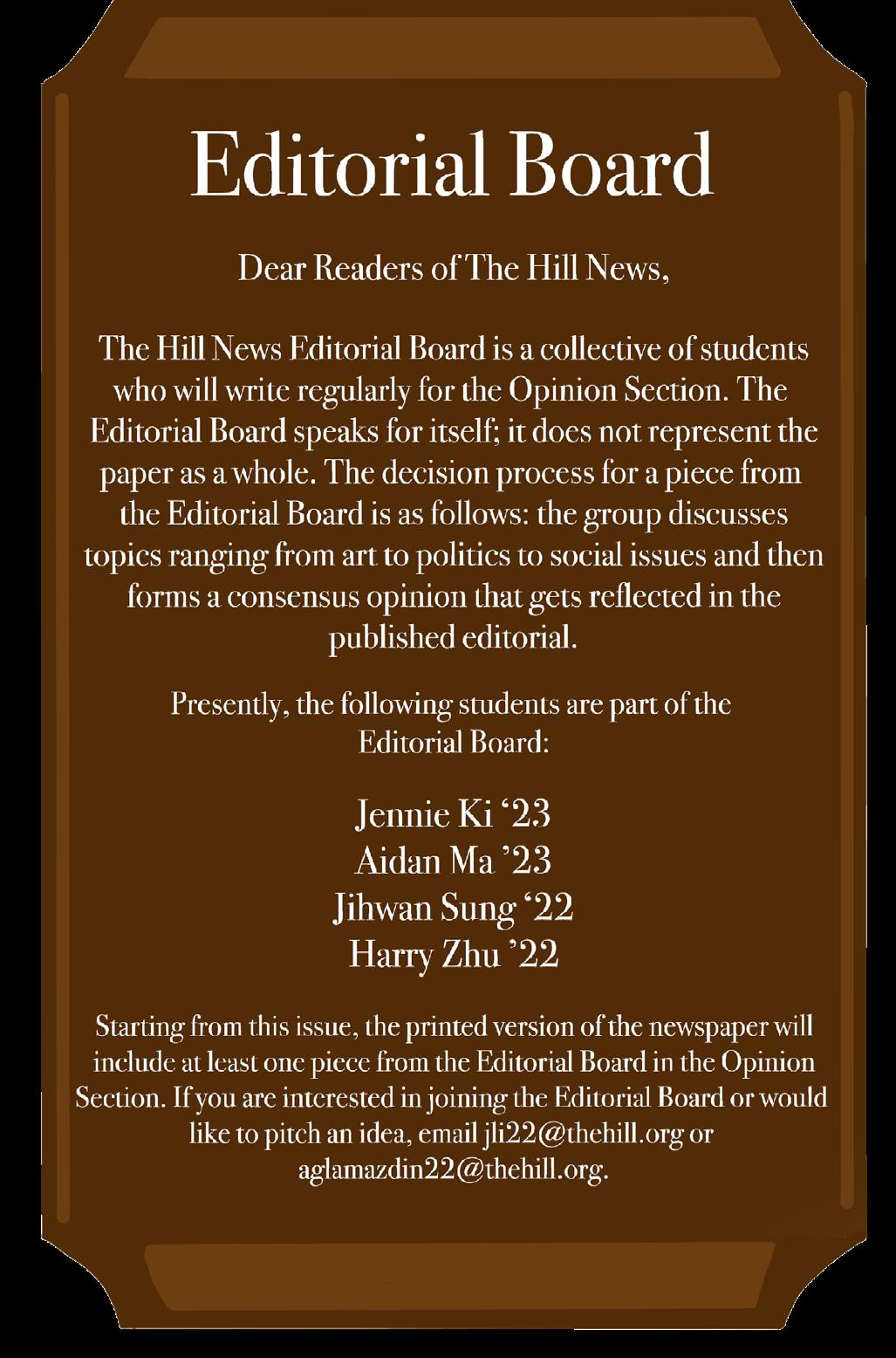
Students take APs because they desire to challenge themselves academically through more advanced, college-level materials. However, APs, with the anxiety and the limitation they bring, have increasingly become a hindrance to students’ academic pursuits. It’s time for us to reconsider the future of APs at Hill.
The first threat of APs comes from pressure and anxiety. Every AP course culminates with an exam in May that evaluates students’ knowledge of the subjects on a scale from 1 to 5, and one or two low scores may be seen as something that can ruin a college application and depreciate one’s hard work in the corresponding year. It’s hard to enjoy academic explorations
when one is stressed about the coming exams in May.
Not only that, condensing a year-long course into an assessment of a few hours for such advanced content is an unjustified way of gauging students’ performances in the class. The AP exam fails to measure student growth, overall learning, and class participation. Yet students feel immense pressure to perform well, fearing that low scores would undermine their academic achievements in the past academic year.
APs also limit students’ academic explorations. According to an NBC News article, leaders from top D.C. private schools believe that “teachers sacrifice in-depth lessons to ensure they cover all of the material that can
potentially appear on the test.” A member of the AP Committee at Hill, Isaac Thomas Chair of Classics Patrick Lake said, “We are probably moving away from APs. The advantage is that it gives us a lot of flexibility to teach what we like, not to have to teach to a test. Especially with Hill’s academic schedule, for some APs, such as AP Biology and AP Latin, it can be a grind getting through all the materials.” As History Fellow Laura McConney said, the “richest veins” of materials covered in class are sometimes not required for AP exams.
However, using the positive aspects of the AP curriculum as a reference, teachers at Hill can add their unique hues to each course, delving deeper into material. Teaching a curriculum of one’s own design can make teaching even more enjoyable and engaging, and students will be able to have more tangential and creative classes. The school will benefit teachers by giving more freedom to tailor their own seminars, labs, or field studies to the needs of high-achieving students at Hill.
Hill has already begun transitioning from rigid AP curriculums – Advanced Environmental Science Seminar is a prime example of how course material can be enriched by moving away from the AP test. Students in that class are now able to learn more about sustainability, as they do not have to waste time
PC gaming becomes a privilege of the rich
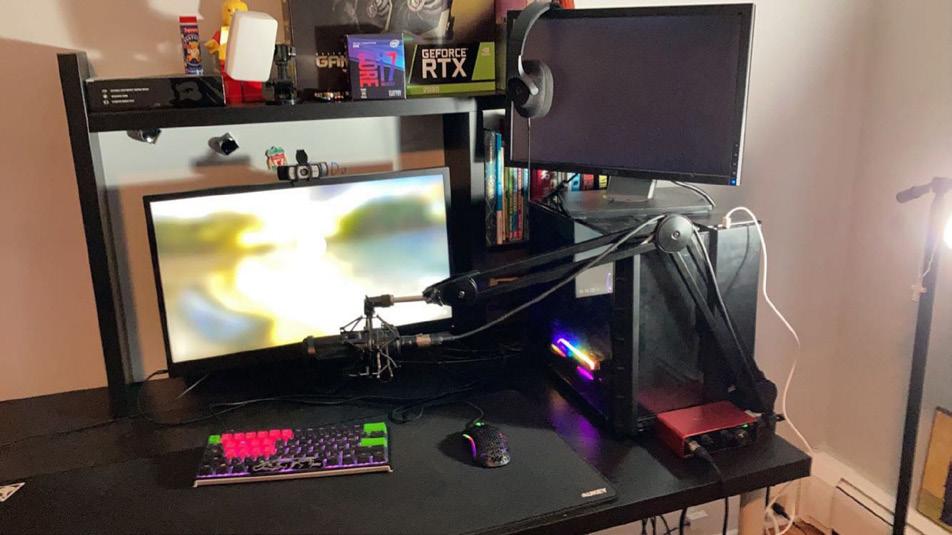 By LOUIS FLEISHER ’21 STAFF WRITER
By LOUIS FLEISHER ’21 STAFF WRITER
Over the past decade, the number of gamers worldwide has more than doubled. From PCs, consoles, to mobile, it feels like everyone has access to video gaming. However, there has been a noticeable jump over the past 10 years in the price to play the latest and greatest in gaming.
Within the last year, two new game consoles have launched with next-generation hardware to play the newest games for years to come. But, even with this new technology in game consoles, some of the newest titles like Cyberpunk 2077 are not comfortably playable at higher resolutions and settings. So, to play the latest games and have them look great at the same time, what do you need?
Well, a high-end, top-ofthe-line, gaming PC seems to be the most popular option. Two of the best-known, and most expensive, components in a PC are going to be the CPU and a graphics card. A CPU is often described as the brain of a computer because it performs the basic operations of the system, exchang-
es data with components, and manages the computer’s components. The graphics card in simple terms is what produces the images you see on your screen. It takes in data and then renders and displays high-quality, high-resolution, 3D images at fast speeds. These are pretty important functions for a computer, so that would explain the expense for them, but costing more than other components is not the problem, it’s the increasing prices for these components. Moreover, new games are continually demanding stronger graphics cards and CPUs each year. When comparing the highest-end graphics cards today to the ones that came out 10 years ago, an alarming trend starts to appear. Looking at the pricing by the major producers of gaming graphics cards, the price has swelled by over 75%. An example of this is the older AMD Radeon HD 6950 which would be $365 and the recent AMD Radeon RX 6800XT at $649. That is a pretty massive increase to see over just a 10-year period.
Today’s top end cards at retail prices are already high, at $1,000 to $1,500, if this trend
continues for the next ten years, prices could rocket up over an extraordinary $2,500. Furthermore, the prices of CPUs ten years ago to now have climbed by almost 50%. The AMD FX-8150 from 2011 priced at around $300 while the modern AMD Ryzen 7 5800x priced at $449 is an example of this. These worrying price increases have been obvious over the past few generations of products to consumers but show no sign of stopping. When I built my first PC in 2016, it was a mid-range computer, which was enough to really play anything very well. Now a mid-range PC costs a bit more than it did then, but the price for a high-end PC has increased exponentially.
So, looking at the prices we have in the present day, a very high-end gaming PC is going to run you about $4,000 or more. To put that in perspective, that’s 5-6% of the yearly median income by U.S. households. This is not even including the cost for the games you are going to play, which for the average U.S. gamer is over $200 a year. Based on all of this, I think it’s clear that at some point soon high-quality, enjoyable gaming will only be done by those who are wealthier, and many will be stuck in the past. While this is obviously not an issue for people who can afford high-end gaming PCs, this will surely leave a bad taste in the mouths of many gamers and seriously hurt the growth of gaming as a hobby and the industry in the near future.
on memorizing the definitions and characteristics of different kinds of soil that can be asked on the AP exam.
The success of replacing APs depends on how the school will utilize the curriculum in the future. It can be a good reference for teachers developing advanced courses. It can also structure the honors and regular courses by informing teachers and students what they would need to succeed in high-level courses. If AP curriculums are used as a reference, we believe there will be a smooth transition from APs to self-tailored advanced courses.
Tips to prepare for AP exams!
U.S. History
“As you wrap up the year in United States History, I’m sure you’re done memorizing datesnow its time to apply the most important component of your history education. Using everything you’ve learned in order to understand movements; what causes people to hate, what drives people to love, what prompts change, and what we in the United States view as worth fighting for, you have the chance to finish the year knowing more about yourself and the storied history of our country - to take the good with the bad and to think critically about our past and future.”
—Gavin Guerette ’21
Physics C Mechanics

“Write down every step, including equations, and don’t be scared when there are no actual numbers in a problem.”
—Audrey Lehneis ’21
Chemistry
“Pay attention to specific lab procedures and units.”
—Audrey Lehneis ’21
Statistics
“One thing to know before stats: remember the difference between sample and population; that’s the core of every problem.”
—Tiffany Wang ’22
Calculus
“Everything about derivatives, integrals, and series in your brain.”
—Tiffany Wang ’22
Increasing corporate tax hinders economic growth
By MICHAEL SOLAND ’21 & EDWARD DENG ’21 STAFF WRITERS
There has been a mountain of disagreements between the Trump and Biden administrations, and corporate tax rates happen to sit near the top. With the talks of President Joe Biden raising and instituting a multinational corporate tax rate for U.S. companies to pay for future infrastructure deals, economists and public opinion are once again at odds. Although it sounds good in theory – making the fat cat corporations pay a cut of their profits for once – corporate tax is one of the more inefficient ways to raise money for the government.
Although policymakers say that a corporate tax would fall exclusively on the producers, it is a fact that that is not the case. The rise in the cost of production will inevitably be reflected in the increase of consumer prices. The other effect of increased corporate
tax can be corporations slashing the wages of workers to retain competitive pricing.
There’s also the problem that a corporate tax lowers the supply of capital available to corporations while also reducing the return in the noncorporate sector. This leads to a decrease in worker productivity and a depression in real wages. Back when the corporate tax was created, corporations typically had monopolistic control over a specific sector of the economy or industry, and, as such, the tax was supposed to bring back profits to the government. However, today, as corporations have become merely another type of business and most monopolistic forms are illegal, this ends up mostly hurting the public. Even the labor required to file corporate taxes hurts the economy. The Tax Foundation estimates that “labor involved in preparing
corporate tax returns takes $150 billion out of the U.S. economy annually.” The corporate tax also affects the shareholders, which can be extremely problematic as most Americans have some presence in the stock market through their retirement accounts and are thereby receiving lower returns.
As the United States has one of the highest corporate tax out of all OECD countries, multinational corporations tend to headquarter themselves in tax havens or use creative accounting to avoid the high taxes stateside. Despite being less than 1% of all U.S. companies, multinational corporations have been responsible for 31% of GDP growth in the private sector. A heightened corporate tax would decrease GDP growth and wages. A global corporate tax with the goal of eliminating tax havens is an even worse idea as there would be no reasonable way to enforce it with the current state of geopolitics. There is no incentive for most European countries to heighten corporate taxes when they have such negative effects on their people.
In today’s political climate, where feelings towards public policy tend to win more votes than stating statistics, the idea behind the effectiveness of a corporate tax raise is emotional. With the damage that the tax increase can cause to U.S. GDP and wages, the United States would take longer to rebound from the aftermath of the COVID-19 pandemic. While there is widespread debate over exact percentages, a reduction to a 10% corporate tax rate would be an efficient way of gaining cash to spend on projects while encouraging beneficial outcomes in the economy.

The Hill News | C4 Opinion APRIL 28, 2021
SUN ’24
PHOTO BY ERICK
ILLUSTRATION BY CLAIRE HARTEMINK ’21
ILLUSTRATION BY HENRY CHEN ’21
ILLUSTRATION BY PORTIA SOCKEL ’22
Costs of PC gaming have soared in recent years.
Hill’s female students discuss how the administration handles sexual abuse
By AVERY LIGGON ’21 STAFF WRITER
For 23 years, women and girls have occupied the halls of The Hill School as students. Looking in from the outside, it is a community that flows with autonomy; but a very different picture is painted from the inside.
When Rev. Mathew Meigs founded the school in 1851, the handbook said Hill was “the family boarding school for boys and young men,” and, even with the addition of women on campus, most girls would say that the school is still for “boys and young men.”
In the fall of 2018, a list ranking the then 4th form girls based on how attractive they were was uncovered. It became apparent then, as it is now, that the “boys and young men” still ruled the school and that there had been very little progress made on the front of gender equity in the school’s 18 years of co-education.

Ari Baum, dean of students, said that this incident was handled “with discipline.” Baum added that the hard truth about such situations is that you never know if discipline is enough.
Baum emphasized that discipline is not the end-allbe-all. He understands that “collateral damage to others can’t be undone or filled in” and that discipline is only a base of the growth that can arise within an aggressor.
Female Hill students want there to be education and dialogue around these topics so that both male and female students alike can spot inappropriate situations and feel empowered to speak up about them. As of now, discipline is the only avenue students see being used to address situations of sexual harassment and assault.
Portia Sockel ’22 said, “There’s not an understanding or an education on the types of things that are acceptable to say.”
Girls on this campus are sexually harassed and assaulted, and they feel as if the school’s ears fall absent to their cries. Female students have to live with the idea that males have an easier time existing on Hill’s campus than they do.
The High Achieving Schools Survey, which Hill students took this fall, determined that both 4th and 6th form students experienced sexual harassment that contributed to mental health struggles.

Kiki Lange ’21 said, “They
 BY AVERY LIGGON ’21
BY AVERY LIGGON ’21
The percentages reflect the number of students in that form that participated in the survey who scored on questions relating to sexual harassment. Percentages outside the black line (norm) would suggest that for that form sexual harassment on campus is affecting mental health.
you,” about her male peers.
She said that boys might not disown you to your face, but they will make their feelings known through other actions, sometimes through spreading rumors or even defaming your image.
This is not a new trend at Hill. It seems to have been an overarching theme in the minds of female students in years past.
Sierra Feldman ’12 said that she could name “a million instances of sexism” from her fellow students during her four years in attendance, whether it was commenting on the length of her skirt or the nickname “Tits” given to her as manager of the baseball team.
The administration plays a key role in the reporting of these events. On Hill’s campus, faculty and staff are mandated reporters. They have an obligation to the law to report any incident they encounter that could be deemed inappropriate.
Baum said that not only does Hill take all of these allegations very seriously, but that “the state of Pennsylvania is unique to the other 49 states” in the way that its laws are shaped to protect victims of harassment and assault, especially in cases concerning minors.
When a situation of a sexual nature is uncovered or reported on campus involving a minor, the Pennsylvania Child Line is called, and the school immediately takes a back seat,
—Lisa
cases involving students 18 and older, but in that case, 911 would be called.
In speaking with Baum, it seems as though Hill clearly has a plan in place for when these things happen; but if that’s really the case, why is it that so many female students still fear coming forward because they feel nothing will happen?
The idea that nothing will be done when you report an event is something that female students observe time and time again, and that seems to be the main reason so many choose to stay silent.
I was told two years ago when reporting an incident to the counseling office that they would approach the person’s coach to handle it before we “made the jump to the dean’s office,” as I was encouraged not to blow anything out of proportion. Because of that, I would not speak up again.
Poppy Otten ’21 said that she had to write a report detailing what happened to her and that she handed it off, never to hear anything about what steps would be taken to protect her on campus.
Izzy Feldman ’21 put it best when she said, “The fact of the matter is, all of this is happening all of the time. And if it’s not happening to you, it’s happening to me, and it’s happening to all my friends, so I think we should stop denying it.”



Hill’s female students are not asking but are begging for the bare minimum on this campus. They want their struggles to be acknowledged, and they want the school’s administrators to work with them to make the sexual abuse reporting process a comfortable and more victim-friendly system.

Female students question if the administration cares. However, the real question we should be asking is this: Why is there such a large disconnect between how the system is supposed to run and how we see it actually working?
Roethling, director of counseling
counseling
harassment and sexting through seminars that have already been carried out during LRP, as well as discussions within the dorms, and the rollout of specific content during Eudemonia classes.
Contact counseling@ thehill.org for more information.
Elizabeth Hudak ’21, Tess McArdle ’21 Olivia Mofus ’22, Aleksandr Glamazdin ’22 Tiffany Wang ’22, Portia Sockel ’22
’22, Jennie Ki ’23, Peirce Hart ’23, MoniYah Person-Henderson ’23, Nimala Sivakumar ’23, Aidan Ma ’23, Erick Sun ’24
Content Policy
The Hill News is the student-run newspaper of The Hill School. Content is determined by and reflects the views of the student editorial board and staff and not school officials or the School itself. The Hill News acts as an open forum for student expression where they have complete control over the content produced.
Want to contribute to The Hill News? Come to our weekly meetings TBA or contact a member of our staff. To submit a letter to the editors or an opinion piece, email ehudak21@thehill.org, tmcardle21@thehill.org, omofus22@thehill.org, aglamazdin22@thehill.org.
April 28. 2021 Opinion C5 | The Hill News
Visual Managing Editors
Editors-in-Chief
Campus News Local News Features Multimedia Social Media Website Opinion Arts & Leisure Sports Photo & Illustration Layout Nari Tung ’21 Carrie Shang
Diemmy
Philippe
Jason
Anna
’23 Efi Miller ’21 Ariana Polevshchikova ’23 Ginta
’23
Staff Writers & Staff Contributers Avery Liggon
Louis
Edward Deng
Izzy
Chen
Chloe
’23
Dang ’24
Jin ’21
Zhou ’23 Olivia Mofus ’22
Carroll
Harada
Raina Shah ’21 Jerry Li ’22 Mofe Akinyanmi ’21 Wesley Connelly ’22 Tess Gray ’21 Rose Flaherty ’22 Claire Hartemink ’21 Sarah Jiang ’22 Tiffany Wang ’22 Jamine Wang ’23
’21, Noorie Dhingra ’21,
Fleisher ’21, Michael Soland ’21,
’21,
Feldman ’21, Sarah Rogalski ’21, Henry
’21,
Han ’22, Paige Timbrook ’22, Melody Chen ’22, Chelsea Mills ’22, Rease Coleman ’22, Anna Guo ’22, Harry Zhu ’22, Jihwan Sung
Faculty Advisor Ms. Elizabeth DeOrnellas
@hillnews @TheHillNews1 thehill.news /whatsoeverthingsarenews
GRAPHIC
ILLUSTRATION BY CHLOE HAN ’22
The
center is working to address problems with both sexual
Jay Spencer returns to head swim coach position
By ELLA SCOTT ’22 STAFF WRITER
A coaching change is returning a veteran to lead Hill’s swim team. Amy Agnew P’11 will become the lead assistant coach during the 2021-22 swim season, as Jay Spencer ’84 P’13 ’14 ’18 ’23 will return to the head coach role.
From 2010 to 2016, Spencer was the head coach of Hill swimming. After graduating from Hill in 1984, Spencer returned to Hill to teach in 2009 after many years serving the U.S. Navy. He was an assistant coach during the 2009-10 season and became the head coach of the program in the 2010-11 season.
During Spencer’s six years as the head coach of the girls and boys swim teams, he prioritized recruiting and training for Easterns, the culminating meet at the end of the winter swim season. This approach worked well, as previously held records were broken and a new era of Hill swimming emerged.
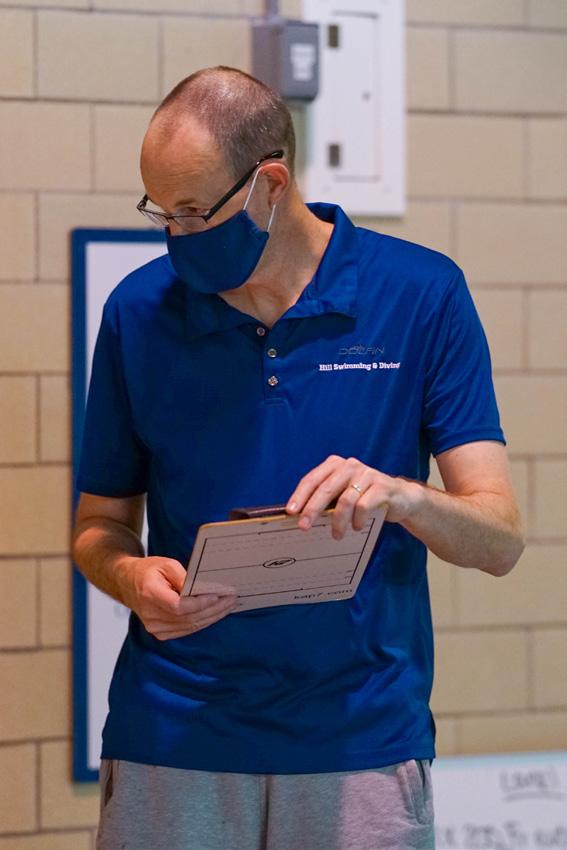
Spencer left Hill for three years after the 2016 season to become a head of school in Alabama, but he
“missed daily teaching interaction with teen students, and especially coaching.” After working at Kent for a year, he returned to campus in 2019 and worked as an assistant coach for the Hill swim team. This swim season, which has been shifted to the spring, Agnew will continue to write practices and coach on deck, while Spencer will work on the administrative side to manage big-picture strategies and meets.
In the summers of 2011 through 2016, Spencer also worked as the head coach for North End Swim Club. When he interviewed for the job at North End, he was taking over the position previously held by Agnew. So, when Spencer was leaving Hill six years later, he thought Agnew would be a great candidate to hand the team off to.
Agnew applied to become an English teacher and the head swim coach at Hill and has been working in both of these roles for the past three years. Spencer and Agnew worked together for the first time last year, and they share similar goals for the program.
This time around, Spencer is planning to implement some of these same strategies from years past to help build the team up to a full junior varsity and varsity roster. He is already starting to recruit prospective students to “build up The Hill’s swim team once again, in both interest and talent.” A major goal that has been continued since Spencer’s first season as the head coach is to integrate the boys and girls swim teams, as well as the diving and swim teams. Similarly, his long- and short-term goals for the team are centered around overall success at Easterns. Spencer is excited to be working on deck again and is emphasizing the mental aspect of swimming, not only physical preparedness.
Gym sign-ups create challenges for athletes
By PIERCE HART ’23 & SARAH ROGALSKI ’21
BY SARAH ROGALSKI ’21 STAFF WRITERS
With recent COVID-19 restrictions, many obstacles, such as a scheduling frenzy, have surfaced this year around the weight room. Kiki Lange ’21, a varsity track athlete, said that some students are signing up for the 6:30 a.m. time slots but taking their names off at 2 a.m. the next day. According to Lange, such behavior prevents sleeping students from signing up for that first slot, creating frustration among students who could not find a time to go at all.
Strength and conditioning coach Steve Notebaert said, “It is different in the sense that we have to be a lot more aware of the max capacity, social distancing, and the masks. It’s definitely a lot more challenging.”
In previous years, there would be about 30 students moving freely about the weight room, coming in and out, and sharing equipment. Now, there is a max capacity of 16 students who must train alone and keep their distance from others.
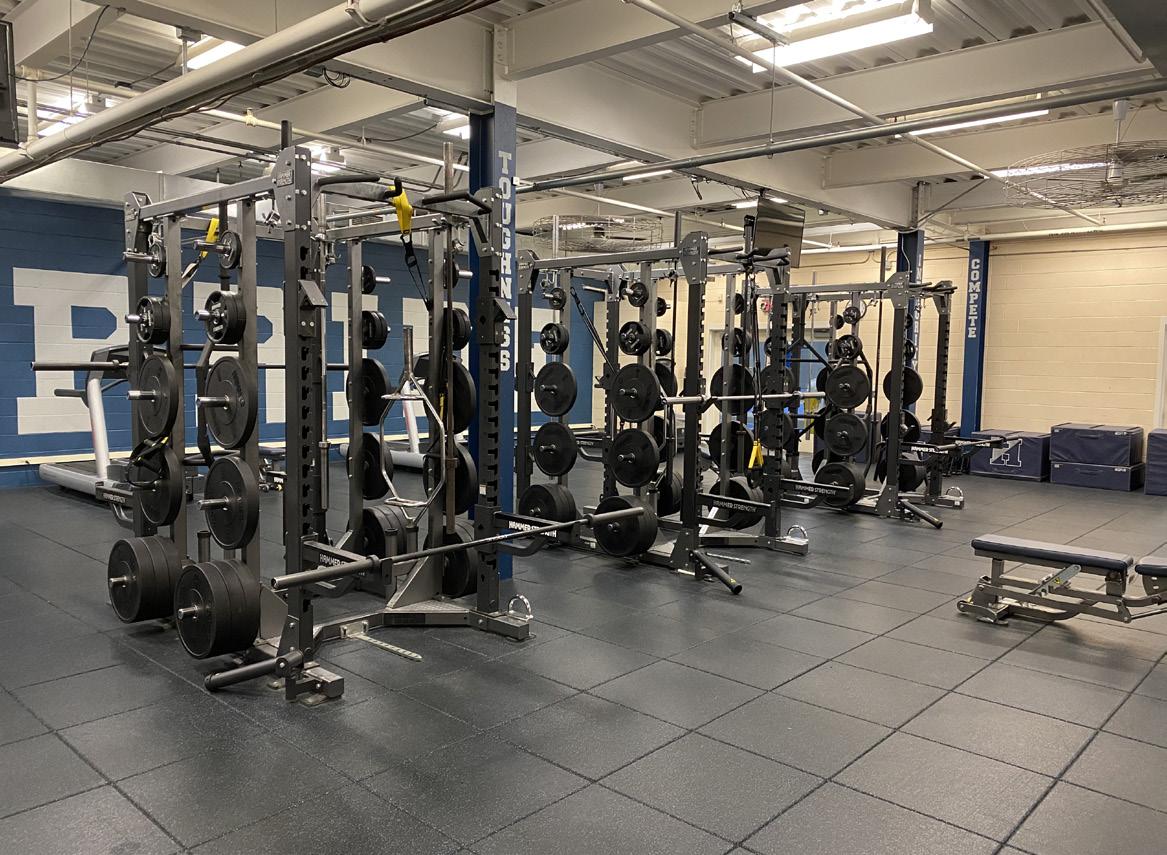
Some students have suggested that the weight room should
consist of free weights, machines and lifting racks only. That would mean moving the treadmills, ellipticals, and other cardio equipment into the field house. Doing so would space out the equipment and allow more people to train at once.
Wearing a mask in the weight room is mandatory for all students and faculty who wish to train in there and use the equipment provided. There is also a 45-minute time limit that each student must sign up for if they desire to work out that day.
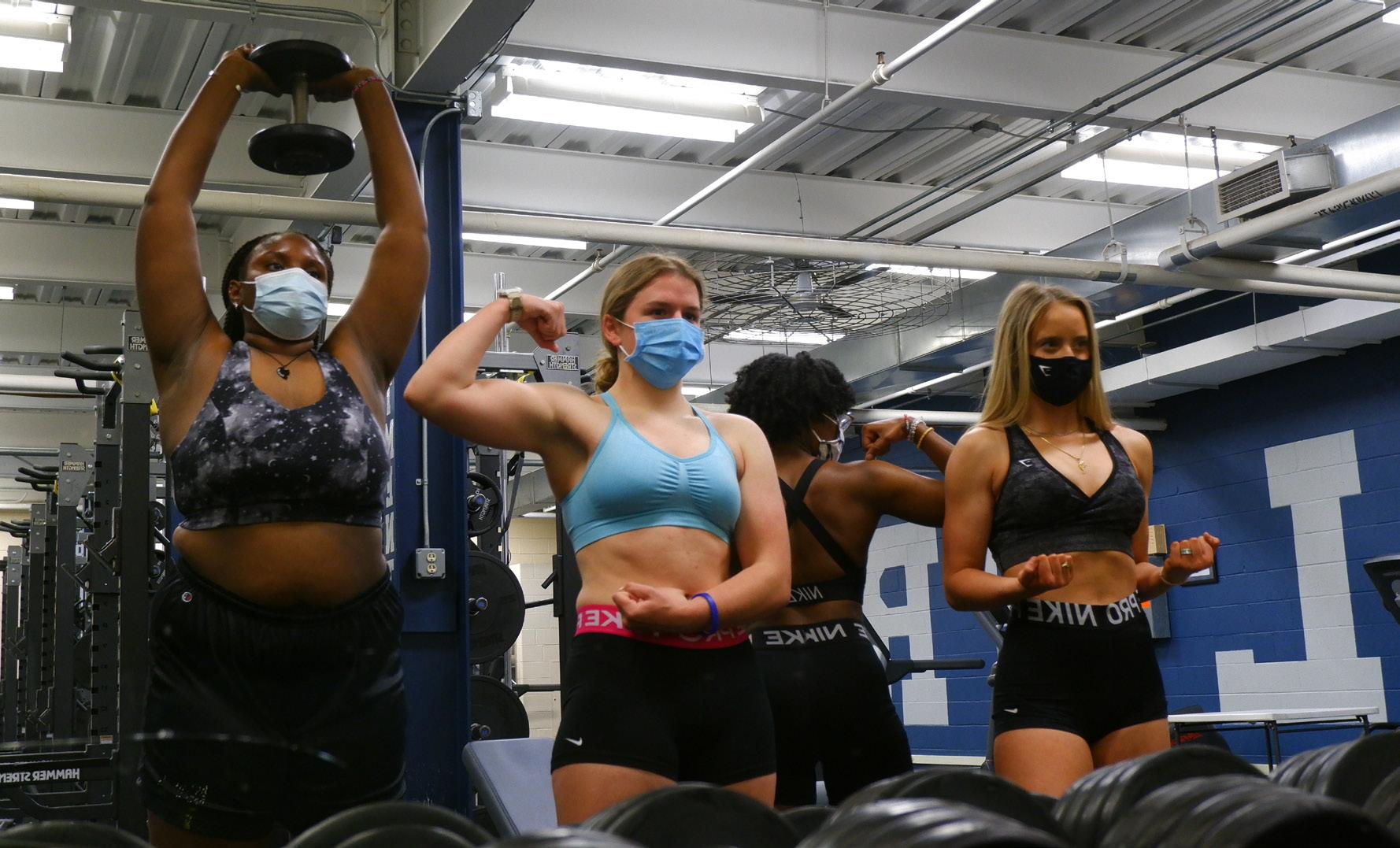
Regarding the 45-minute time slots, varsity football and lacrosse player Cooper Sugden ’21 said, “For me, as an athlete – and I know for a lot of other aspiring college athletes – it’s not fair.”
He notes that it is hard to get a good workout in such a short time and that it feels “rushed.” Sugden also said that the faculty should not expect to produce better student-athletes by limiting their gym usage.
Lange said, “I would prefer to go back to one-hour slots.” The
extra 15 minutes would allow those who are working out to get in a good warmup and have time to complete a full lift.
Faculty and student leaders have put together an Excel signup sheet to try to enforce the new rules. Brian Artim, the athletics equipment room manager, said signing up for early times has been hard because everyone is fighting to find an open time slot before school.
“People are deleting other people’s names” off the list and taking their time slot, Artim said, adding that this is a major problem that needs to be addressed.
Possible solutions to these issues, as suggested by Lange, could be creating a system in which students can only sign up for a morning slot a certain amount of times a week and sending the list out to everyone at the same time each day. This way the same people are not reserving the same time slots every day, and those who wish to sign up can be prepared for when they receive the list.
Female athletes challenge new dress code expectations
By IZZY FELDMAN ’21 STAFF WRITER
An “Indoor Athletics Facility Dress Code” was recently approved by the Athletics Department and announced in the April 16 issue of the Today on the Hill newsletter. The dress code detailed various items that are no longer permitted to be worn, such as shirts that “reveal the midsection or torso,” and instead prompted students to wear tops that are “similar to a basketball jersey.”
Preceding the announcement, there had been an increase in dialogue amongst female students regarding faculty’s place in deciding what is appropriate athletic wear.
This was following a handful of girls mentioning that they had been asked by various faculty to change while using the athletic facilities, with others receiving demerits.
It’s likely that the new dress code will upset many on Hill’s campus, being that various girls had voiced their frustrations prior to it being finalized.
Parker McQuaid ’21 said that the conversation amongst faculty about gym wear being inappropriate made her “feel ashamed” and that “women’s workout clothes are made to be functional.”
Avery Liggon ’21 was in agreement with McQuaid, saying“crop tops and sports bras are normal workout attire.”
Head prefect Kirsten Lange ’21 put this current conversation about modesty into the context of the handbook, saying that “the girls dress code in our
handbook uses the word ‘conservative’ twice.”
Lange went on to explain the various expectations of girls to follow while being in academic dress, including intimate details from how many buttons should be buttoned on a girl’s blouse to what days female students can wear dresses on.
“I understand that during the academic day we should dress as professionals, but what I cannot seem to wrap my head around is why it matters what I wear to the gym,” Lange said.
“As a 6th form girl on this campus, I am disgusted and honestly ashamed that our school wants to ban girls from wearing cropped shirts while we work out and sweat.”
SGA co-president Sasjha Mayfield ’21 shared similar sentiments.
“I understand that Hill is traditional and values modesty, particularly when it comes to female students, but in my opinion the weight room should be a place where we wear whatever makes us feel confident and strong,” Mayfield said.
Poppy Otten ’21 stated in a message, “This issue has been driven beyond expectations of traditional dress code and rather exacerbates issues of body image,”–– two things McQuaid said go hand-in-hand.
“Working out and body image are so interconnected. Working out can be a difficult thing, or a stressful thing, even a triggering thing. I think about girls who have to muster up the confidence to go to the gym, and who feel proud of themselves and maybe
a little insecure when they finally get there, and thinking about them getting told that the outfit they’re wearing isn’t okay ... something like that would make me never want to go back,” McQuaid said.
Lauryn Fudala ’21 shared, “I heard one girl say that the gym is her safe space and that if she can’t feel comfortable wearing what she wants and has to continue to be around certain faculty members who have told her to put more clothes on, that then her safe space is taken away from her, and I think that that’s the case for a lot of people.”
“If the faculty are the only people who have a problem with the gymwear, then girls wearing crop tops isn’t the problem, it’s them,” Lange said.
Before the dress code was implemented, Mayfield, alongside SGA co-president Andrew Chirieleison ’21, and Otten, the 6th form female SGA representative, spoke to the strength and conditioning coaches Stephen Notebaert and Deanna Mayza ’13 amidst rumors of its proposal.
In an interview about the meeting, Mayfield said, “Mr. Notebaert and Coach D. were extremely willing to listen to Poppy, Andrew, and my
concerns about the weight room dress code. They were understanding and stressed to us that their No. 1 priority is making sure ALL Hill students feel comfortable in that environment.”
Mr. Notebaert, in response to the dress code and potential concerns students may have with it, wrote in a written statement: “The Athletics Department gathered insights from a number of student leaders prior to developing and finalizing the indoor facility dress code. If students have specific questions about the dress code, the Athletics Department would be happy to schedule time to discuss.”

The Hill News | D6 Sports APRIL 28, 2021
PHOTO
Jay Spencer has taken over as head swim coach.
PHOTO BY ERICK SUN ’24
PHOTO BY SARAH JIANG ’21
Cynthia Williams ’21, Tess Gray ’21, Sasjha Mayfield ’21 and Laura Null ’21 model now-prohibited athletic apparel.
Hill’s weight room is subject to COVID-19 regulations.
Crypto Art and NFTs: Call it a gimmick or a new frontier?
 By AIDAN MA ’23 STAFF WRITER
By AIDAN MA ’23 STAFF WRITER
How would you imagine the typical auction scenario to be?
Maybe you would envision a cold, stark room, silent except for the sound of the auctioneer calling out numbers and pounding away with a gavel, selling million-dollar paintings and statues. But what if the situation was completely different? Instead of an auction room, maybe it’s a website, and instead of a million-dollar painting, it’s a $69 million JPEG. That’s the basic premise of the NFT world: an assortment of decentralized online spaces to buy and sell artwork; only, the artwork is made up of pixels on a screen instead of paint and clay. So what is an NFT? To those uninitiated in the worlds of either finance or fine arts, the concept of an NFT, or non-fungible token, can be difficult to grasp— and to those who understand, it can still be viewed as ridiculous. How would a completely digital piece with no physicality to back up its value possibly be worth millions of dollars? The answer to that question is complicated. Uti -
lizing blockchain technology, a way to decentralize, or distribute, the process of buying and selling, as well as to keep permanent records of transactions, each NFT is unique, and that uniqueness is an essential part of guarding its value: hence “non-fungible.”
Mike Winklemann, a digital artist better known as Beeple, is one of the most successful artists that utilize NFTs as their main form of media. Known for his provocative and colorful works,
his piece, Everydays—The First 5000 Days, sold for a whopping $69 million, landing Winklemann in the position as one of the top three highest-paid living artists in the world and making history as the first NFT sold at an auction. A collage of 5,000 of his works, the JPEG file was sold to Vignesh Sundaresan, who has the rights to display the artwork but does not own the copyright.
Athey Family Master of the Arts, Diane Richards, described
watching Beeple in interviews as fascinating. “So that’s the point right, we want to pay artists for what they’re doing, and artists should, especially in a digital age, be able to be compensated,” Richards said. “The problem with it though is, it’s supposed to be decentralized right, there’s no one really overseeing it. The problem with that is, you’re taking chances. If you really need help as an artist, it’s going to be difficult, for both the seller and the buyer.”
Senior Master of the Arts Ellen Nelson provided some insight as to why NFTs might have exploded in popularity recently. “I think the surge in popularity has at least two factors working in its
favor,” Nelson said. “The first being investors have had some time to study whether or not NFTs have maintained their value. The second is the pandemic — people have had time to look into alternate venues for investment. If you have the money, you can buy and sell NFT art through sites such as Rarible and OpenSea. Who knows what the future will bring, but I believe we’re seeing the beginning of cryptocurrency and NFTs. If I knew that for sure, I could make a great deal of money.”
Unfortunately, it’s not all sunshine and rainbows in the NFT world. Many people, including Winklemann himself, have described the current state of crypto art as a bubble, with investors massively inflating the value of these pieces. The landscape of crypto art is relatively new, so it’s hard to judge where these artworks should be valued, and if these statements have any merit to them. Whether or not people are right in calling NFTs a bubble that might soon burst is difficult to tell, and the future is unclear as to what direction the art world is headed in.
Live music returns in the spring
By ANNA GUO ’22 STAFF CONTRIBUTOR
The lights dim as hundreds of students and parents pour into the auditorium. Rows of red chairs gradually fill to capacity, and snippets of whispered conversation can be heard. Students flip through the program while parents catch up with one another, waiting for the conductor to step on the stage. The air is heavy with anticipation, eagerly awaiting the lively performance.
using bell coverings for wind instruments. “These efforts are what will ultimately gain her approval to hold a live concert,” Neiswender added.
Musical memories throughout the years: Hill looks back on its musical beginnings
By NIMALA SIVAKUMAR ’23 & MONIYAH PERSON-HENDERSON ’23 STAFF CONTRIBUTOR
The Hill School is well-known for many things, one being its musical arts program. Students have the opportunity to participate in orchestra, jazz, chorus, piano, and many other programs and classes. Besides its current music scene, the Hill also boasts a rich musical history.
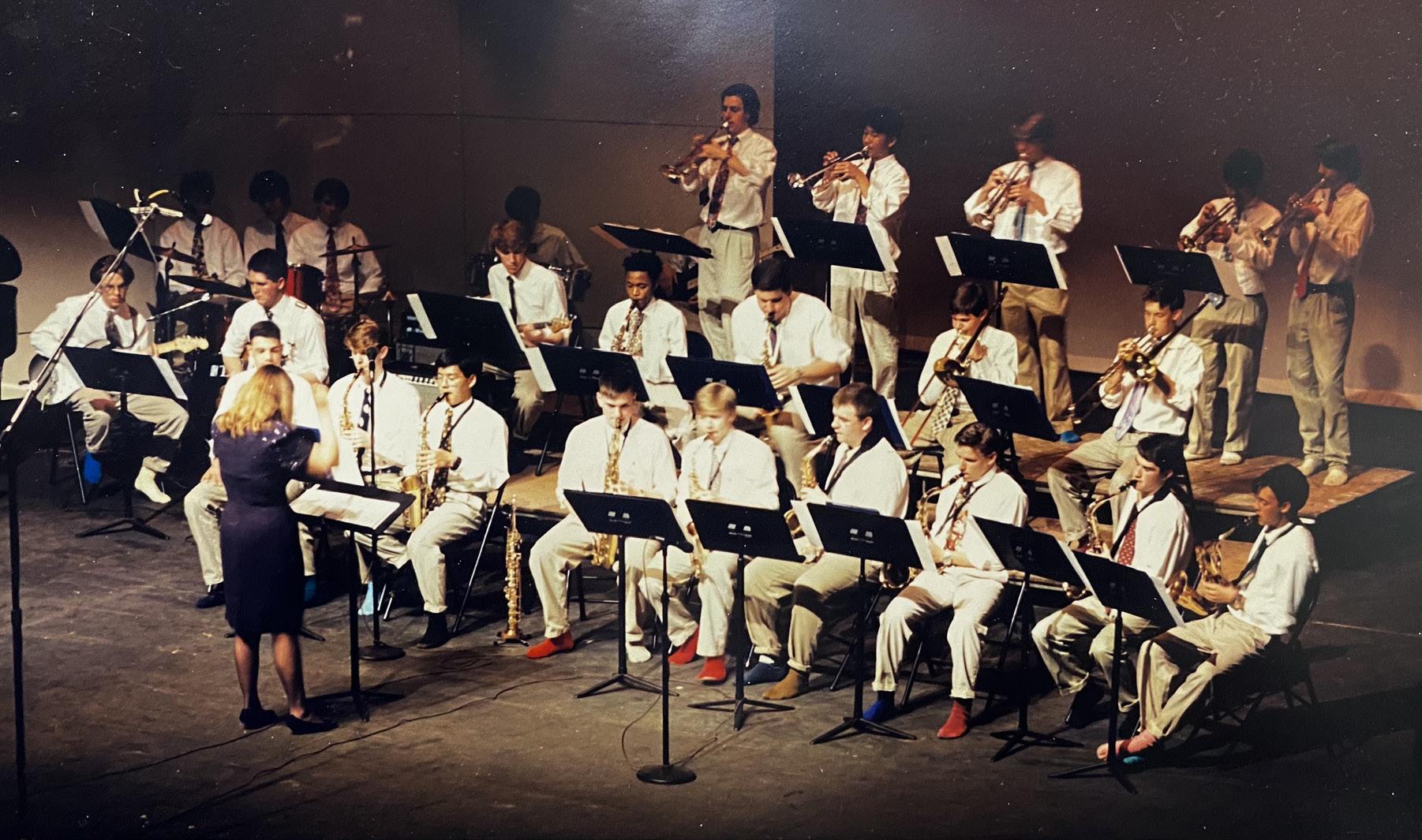
With a total of 37 instrumental music faculty throughout its history, Hill currently has three still serving: Senior Master of the Arts Margaret Ritchie Neiswender, employed at Hill since 1986; Oaklawn-Tuttle Director of Vocal Music Yoon Soo Lim, who began at Hill in 2014; and Garrison Smith ‘15. These three keep the music program alive today.
Neiswender, one of the longest-serving faculty members, transformed the music department with her formation of Hill’s first orchestra.
“The first orchestra was just an oboe, flute, and a violin!” Neiswander laughed. She went on to describe how band practice worked before the CFTA. With no separate practice rooms, instrumentalists used what is currently faculty housing as rehearsal space.
Bill Robertson ‘92, an alumnus
STAFF WRITER
of the Hill School who was deeply involved in the music program at Hill, shared some musical memories, saying, “In the late 80s and early 90s, there was an amazing live music scene.”
Together, Neiswender, Jim Reifsnyder, an instructor of history at the time, and a talented student body expanded the music program. Live music was a big aspect of Hill at the time, with school dances, coffee house performances, and open mics all being popular weekend activities.
“I think I was in probably five or six different bands over my career. We would sneak into the CFTA (newly opened by the way) to rehearse. We loved playing together so much,” Robertson said.
Music can be a great outlet for many students, and it meant a lot to Robertson. This motivated the creation of the Summit Jam, the musical component of the Leadership and Career Summit that existed for almost a decade in the 2010s. “The concept was to provide a super fun atmosphere for current students to get together and just play.”
Brian McTear, an alumnus who began his Hill career in 1987, gave
insight into Hill arts at the time. “The CFTA opened my 5th form year,” McTear said. “For that first year, the school didn’t have nearly a full schedule’s worth of uses for the building, and so, as Bill mentioned, a small group of us sorta claimed it for ourselves.”
During McTear’s last two years, the CFTA was a safe space for him and his friends. “Mrs. Neiswender (then ‘Miss Ritchie’) was incredibly generous to me personally. I often remind her that she actually took my 6th form band ‘Mothers Garden’ on our first road trip - a chance to play at an all-girls school (The Fox School in Va.) to play a battle of the bands. The band returned in later years to perform at many formal dances along with the spring fling! I also recall returning to see my younger brother Brendan’s band ‘Ra The Sun God’ play as well. That night’s performance resulted in some real controversy when he yelled the F-word through the PA before one of the songs, resulting in the show being shut down. Ha,” McTear said.
To read the full article, visit thehill.news.
Due to COVID-19, students at Hill have not performed live music in over a year. However, with recent vaccinations and other campus safety protocols implemented, live student performances will be returning in the CFTA this spring. Margaret Neiswender, senior master of the arts, has given the following tentative dates: the Hill Jazz Ensemble will perform on May 12 at 7 p.m.; the Hill Orchestra will perform on May 13 at 7 p.m.; and the Dance Recital will perform on May 14 at 8 p.m.
“All of these indoor performances will be with a reduced capacity residential community audience,” Neiswender said. “We are hoping to livestream the performances as well.”
Dr. Kristen Spencer, the school’s medical director, has guided Hill’s music program throughout the pandemic by implementing physical distancing measures for musicians and
As for Hill Vocal Music, they performed a live concert on April 24. “It will be a Saturday night outdoor event, instead of a traditional Friday night,” Yoon Soo Lim, Oaklawn-Tuttle director of vocal music, explained in advance. “It won’t be super long, and it will be open to residential students and faculty.” The concert, which also featured a student band, was held in front of the library.
Because of COVID-19 safety parameters, Hill Tones and Trebles performed the traditional candlelight services digitally last fall. “The choir was able to record three Christmas carols, and everything was virtual,” Lim said. “We’ve had a long time in isolation, and we would have to retrain to practice performing together again.”
This year has been unpredictable in many ways for Hill students and musicians. “The band has adapted and proven itself capable of preparing for something entirely new,” Max Robertson ‘21, co-president of the Hill Jazz Ensemble, said. “This final concert will be something familiar yet completely different – we hope to see you there!”
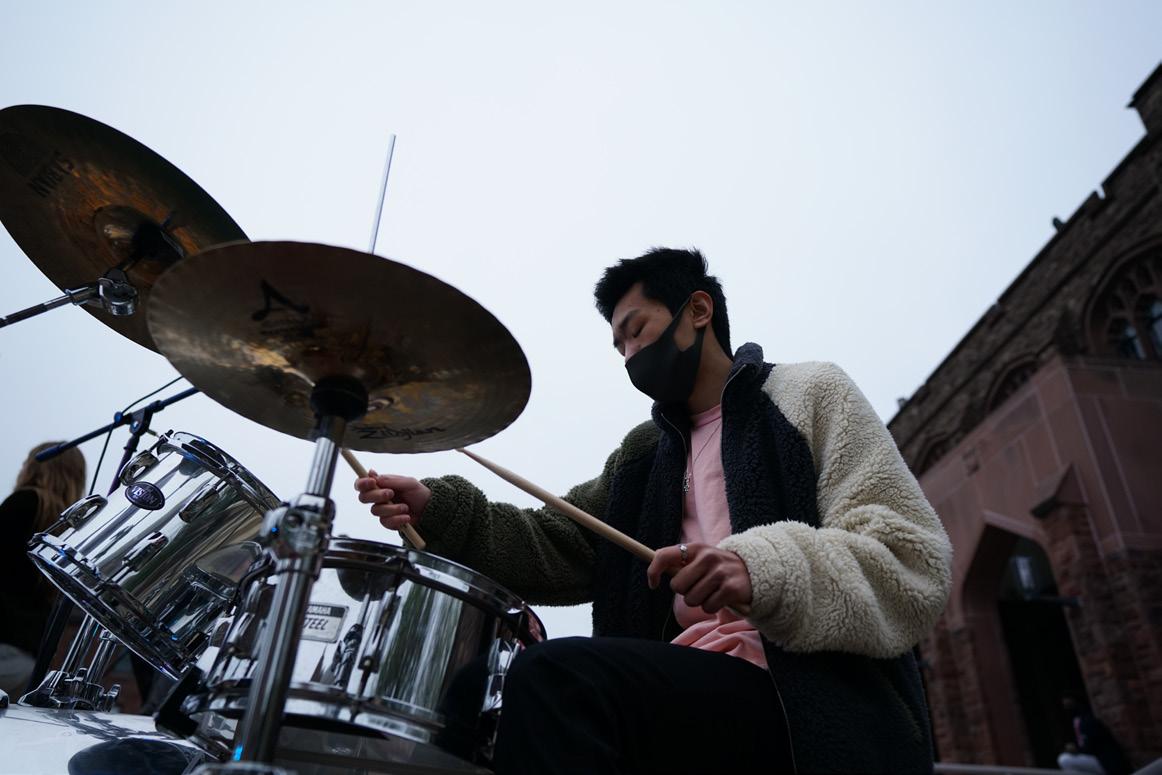
April 28. 2021 Arts & Leisure E7 | The Hill News
PHOTO BY SARAH JIANG ’22
This archived photo, located in the CFTA, shows one moment in Hill’s long musical history.
PHOTO BY ERICK SUN ’24
Ric Guan ’23 performs in the 28-24 student band during the April 24 concert.
ILLUSTRATION BY AIDAN MA ’23
Who knows what the future will bring, but I believe we’re seeing the beginning of cryptocurrency and NFTs. If I knew that for sure, I could make a great deal of money.
—Senior Master of the Arts Ellen Nelson
Spring style in full bloom


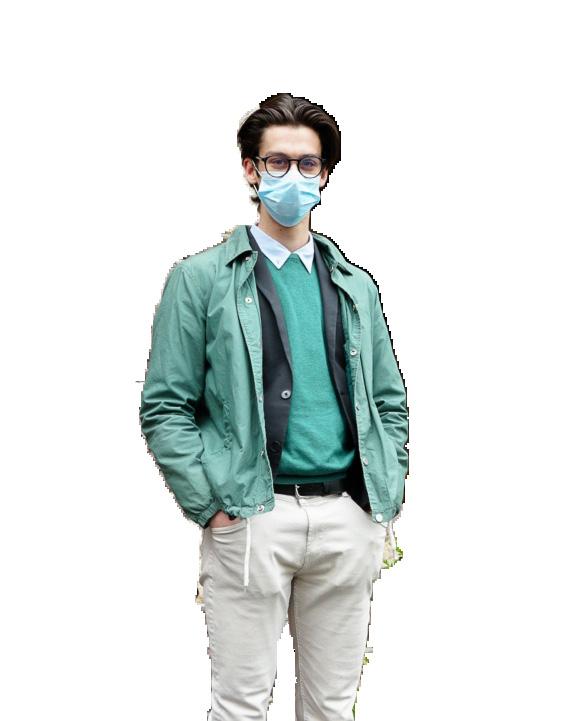
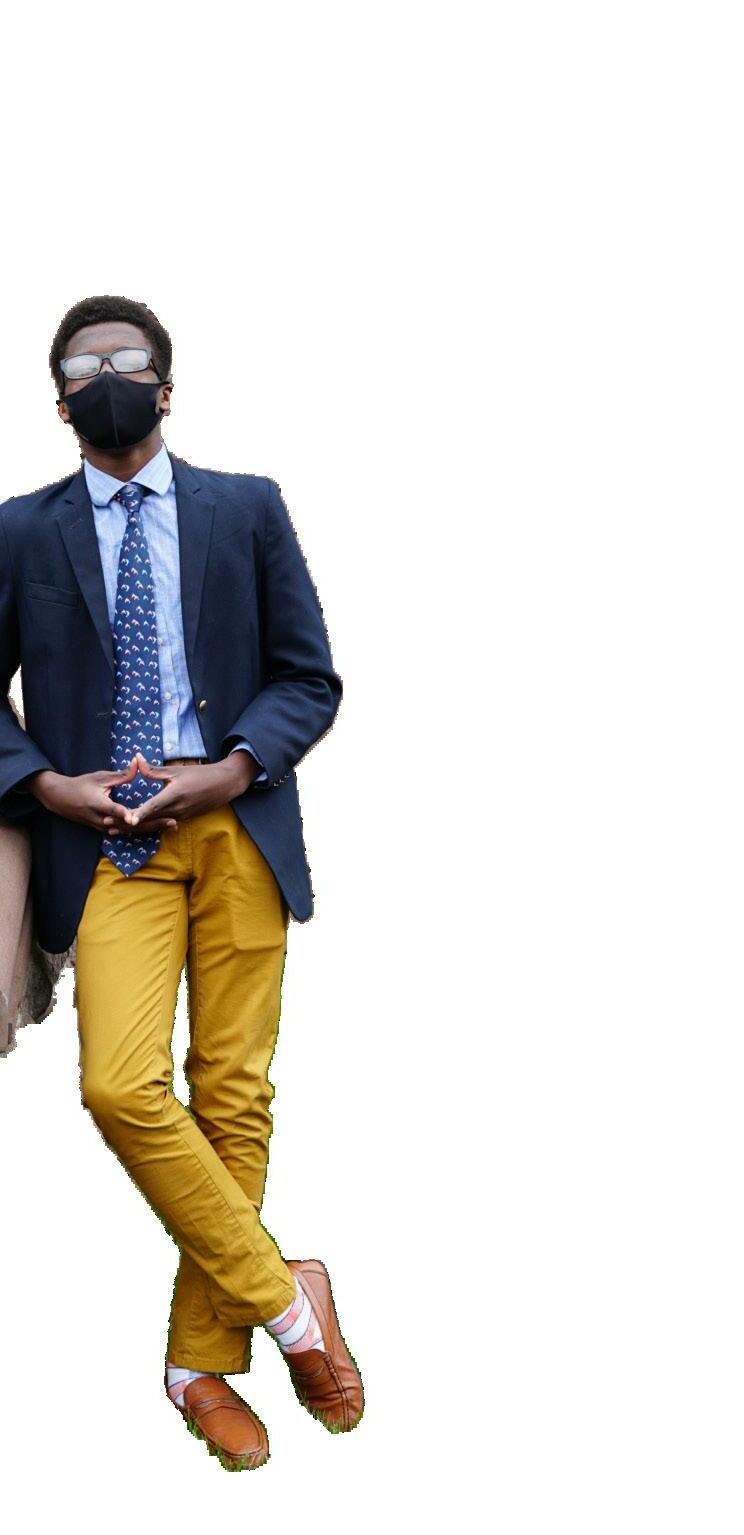 By PORTIA SOCKEL ’22 VISUAL MANAGING EDITOR
By PORTIA SOCKEL ’22 VISUAL MANAGING EDITOR

Springtime bids welcome to a unique energy on Hill’s campus. Tights, puffy coats, and turtlenecks cease to be worn and a warm breeze blows over the newly green Quad. Stems begin flowers adorn the trees that line our campus. The sunshine and s trends and high spirits. The confluence of fresh change found in code. Featured here are six Hill students who vibrantly reflect springtime.
2) Lal Yatagan

APRIL 28, 2021
“Students should be able to express themselves in any way they want and I do that through my clothes and makeup; it’s much more fun to be me than to just fit in.”
“My style is who I am and how I present myself to others, and because of that, I pay a lot of attention to what I put on myself. I like minimalistic fits that match colors because it’s not too complex and always looks good.”
As the snow melts, students get drippy 1) Jed Korankye 5) Aidan Ma 3) Tytus Felbor 4) Geordie Ravara
“I think that it reflects staying in dress code while showing off your own style.”
6 3 2 1
“I think fashion is a great way for people to express themselves. What you wear can be described as a type of art, so by dressing up in a certain way, you can be expressing yourself through your clothing.”












 By MONIYAH PERSON-HENDERSON ’23 STAFF WRITER
By MONIYAH PERSON-HENDERSON ’23 STAFF WRITER

 By LOUIS FLEISHER ’21 STAFF WRITER
By LOUIS FLEISHER ’21 STAFF WRITER




 BY AVERY LIGGON ’21
BY AVERY LIGGON ’21








 By AIDAN MA ’23 STAFF WRITER
By AIDAN MA ’23 STAFF WRITER





 By PORTIA SOCKEL ’22 VISUAL MANAGING EDITOR
By PORTIA SOCKEL ’22 VISUAL MANAGING EDITOR

